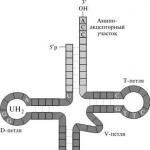What is the transcription process? RNA receives hereditary information
Initiation of transcription
Transcription elongation
The moment at which RNA polymerase transitions from transcription initiation to elongation is not precisely determined. Three major biochemical events characterize this transition in the case of Escherichia coli RNA polymerase: the release of the sigma factor, the first translocation of the enzyme molecule along the template, and the strong stabilization of the transcription complex, which, in addition to the RNA polymerase, includes the growing RNA chain and the transcribed DNA. The same phenomena are also characteristic of eukaryotic RNA polymerases. The transition from initiation to elongation is accompanied by the rupture of bonds between the enzyme, promoter, transcription initiation factors, and in some cases, by the transition of RNA polymerase to a state of elongation competence (for example, phosphorylation of the CTD domain in RNA polymerase II). The elongation phase ends after the growing transcript is released and the enzyme dissociates from the template (termination).
Elongation is carried out with the help of basic elongation factors, which are necessary so that the process does not stop prematurely.
Recently, evidence has emerged showing that regulatory factors may also regulate elongation. During the elongation process, RNA polymerase pauses at certain parts of the gene. This is especially clearly seen at low concentrations of substrates. In some areas of the matrix there are long delays in the advancement of RNA polymerase, the so-called. pauses are observed even at optimal substrate concentrations. The duration of these pauses can be controlled by elongation factors.
Termination
Bacteria have two transcription termination mechanisms:
- a rho-dependent mechanism in which the Rho (rho) protein destabilizes the hydrogen bonds between the DNA template and the mRNA, releasing the RNA molecule.
- rho-independent, in which transcription stops when the newly synthesized RNA molecule forms a stem-loop, followed by several uracils (...UUUU), which leads to the detachment of the RNA molecule from the DNA template.
Transcription termination in eukaryotes is less studied. It ends with cutting the RNA, after which the enzyme adds several adenines (...AAAA) to its 3" end, the number of which determines the stability of a given transcript.
Transcription factories
There is a number of experimental data indicating that transcription occurs in the so-called transcription factories: huge, according to some estimates, up to 10 Da complexes that contain about 8 RNA polymerases II and components for subsequent processing and splicing, as well as correction of the newly synthesized transcript. In the cell nucleus, there is a constant exchange between pools of soluble and activated RNA polymerase. Active RNA polymerase is involved in such a complex, which in turn is a structural unit that organizes chromatin compaction. Recent data indicate that transcription factories exist even in the absence of transcription, they are fixed in the cell (it is not yet clear whether they interact with the nuclear matrix of the cell or not) and represent an independent nuclear subcompartment. The transcription factory complex containing RNA polymerase I, II or III was analyzed by mass spectrometry.
Reverse transcription
Reverse transcription schemeSome viruses (such as HIV, which causes AIDS), have the ability to transcribe RNA into DNA. HIV has an RNA genome that is integrated into DNA. As a result, the DNA of the virus can be combined with the genome of the host cell. The main enzyme responsible for synthesizing DNA from RNA is called reversease. One of the functions of reversetase is to create complementary DNA (cDNA) from the viral genome. The associated enzyme ribonuclease H cleaves RNA, and reversease synthesizes cDNA from the DNA double helix. The cDNA is integrated into the host cell genome by integrase. The result is the synthesis of viral proteins by the host cell, which form new viruses. In the case of HIV, apoptosis (cell death) of T-lymphocytes is also programmed. In other cases, the cell may remain a spreader of viruses.
Some eukaryotic cells contain the enzyme telomerase, which also exhibits reverse transcription activity. With its help, repeating sequences in DNA are synthesized. Telomerase is often activated in cancer cells to indefinitely duplicate the genome without losing the protein-coding DNA sequence.
Notes
Wikimedia Foundation. 2010.
See what “Transcription (biology)” is in other dictionaries:
- (from Latin transcriptio, lit. rewriting), biosynthesis of RNA molecules, resp. DNA sections; the first stage of genetic implementation. information in living cells. It is carried out by the enzyme DNA-dependent RNA polymerase, to the paradise of most studied... ... Biological encyclopedic dictionary
biology- BIOLOGY (from the Greek bio life and logos word, doctrine) the totality of sciences about life in all the diversity of manifestations of its forms, properties, connections and relationships on Earth. The term was first proposed simultaneously and independently in 1802... ... Encyclopedia of Epistemology and Philosophy of Science
The science of life that includes all knowledge about the nature, structure, function and behavior of living things. Biology deals not only with the great variety of forms of different organisms, but also with their evolution, development and with those relationships that... ... Collier's Encyclopedia
BIOLOGY- a set of sciences about life in all the diversity of manifestations of its forms, properties, connections and relationships on Earth. The term was first proposed simultaneously and independently of each other in 1802 by the outstanding French scientist J.B. Lamarck and German... ... Philosophy of Science: Glossary of Basic Terms
I Transcription (from Latin transcriptio rewriting) written reproduction of words and texts, taking into account their pronunciation using a certain graphic system. T. can be scientific and practical. Scientific T. is used in linguistic...
- (from Latin transcriptio, letters rewriting), RNA biosynthesis on a DNA matrix; the first stage of genetic implementation. information, in the course of cutting the nucleotide sequence of DNA is read in the form of a nucleotide sequence of RNA (see Genetic code) ... Chemical encyclopedia
Pre mRNA with stem loop. Nitrogen atoms in the bases are highlighted in blue, oxygen atoms in the phosphate backbone of the molecule in red. Ribonucleic acids (RNA) are nucleic acids, polymers of nucleotides that contain an orthophosphoric acid residue ... Wikipedia
A science that aims to understand the nature of life phenomena by studying biological objects and systems at a level approaching the molecular level, and in some cases reaching this limit. The ultimate goal is... ... Great Soviet Encyclopedia
Reverse transcription is the process of producing double-stranded DNA from a single-stranded RNA template. This process is called reverse transcription, since the transfer of genetic information occurs in the “reverse”, relatively ... ... Wikipedia
The request "Virus" is redirected here. See also other meanings. ? Viruses Rotavirus Scientific classification Overkingdom ... Wikipedia
After deciphering the genetic code, the question arose: how is information transferred from DNA to protein? Biochemical studies have established that the bulk of DNA in a cell is localized in the nucleus, while protein synthesis occurs in the cytoplasm. This territorial separation of DNA and protein synthesis led to the search for an intermediary. Since protein synthesis took place with the participation of ribosomes, RNA was put forward to play the role of an intermediary. A diagram was created illustrating the direction of the flow of genetic information in a cell:
DNA → RNA → protein
It is called the central dogma of molecular biology. F. Crick postulated that the synthesis of macromolecules according to this scheme is carried out according to the matrix principle. It took many years to prove the correctness of this postulate.
At first it was assumed that ribosomal RNA (“one gene - one ribosome - one protein”) played the role of an intermediary. However, it soon became clear that this assumption was untenable. It has been shown that during protein synthesis the number of ribosomes does not change, i.e. new RNA is not synthesized and, therefore, no new information is received. Soon, a fraction of unstable RNA was discovered in the composition of ribosomes, the molecules of which are loosely held on the ribosome with the help of Mg cations. Using molecular hybridization, it was shown that the molecules of this RNA are copies of certain sections of DNA. She got the name matrix, or messenger RNA. It was also previously called messenger RNA and messenger RNA. The complementarity of these molecules to certain sections of DNA indicated that they were synthesized according to a template type on DNA.
Gradually, the entire path of information transfer from DNA to protein was clarified. It consists of two stages: transcriptions And broadcasts. At the transcription stage, genetic information is read and transferred from DNA to mRNA. The transcription process occurs in three stages: initiation, elongation And termination. Information is read only from one DNA chain (+ chain), since, based on the properties of the genetic code, complementary DNA sections cannot encode the structure of the same protein due to the lack of complementary degeneracy of the code. Transcription is carried out by the enzyme RNA polymerase, which consists of four subunits (ααββ") and does not have specificity regarding the source of DNA. At the initial stage of transcription - initiation - a fifth subunit, the so-called s-factor, is attached to the enzyme, which recognizes a specific section of DNA, promoter. Promoters are not transcribed. They are recognized by the s-factor by the presence of a specific nucleotide sequence in them. In bacterial promoters, it is called the Pribnov block and has the form TATAAT (with slight variations). The enzyme RNA polymerase is attached to the promoter. The growth of the mRNA chain occurs in one direction, the transcription rate is ≈ 45-50 nucleotides per second. At the initiation stage, only a short chain of 8 nucleotides is synthesized, after which the s-factor is separated from RNA polymerase and the elongation stage begins. The extension of the mRNA chain is carried out by a tetramer protein. Section , from which information is read, is called a transcripton.It ends with a terminator - a specific nucleotide sequence that plays the role of a stop signal. Having reached the terminator, the RNA polymerase enzyme stops working and, with the help of protein termination factors, is separated from the matrix.

In bacterial cells, the resulting mRNA molecules can immediately serve as templates for protein synthesis, i.e. broadcast. They connect to ribosomes, to which transport RNA (tRNA) molecules simultaneously deliver amino acids. Transfer RNA chains consist of approximately 70 nucleotides. A single-stranded tRNA molecule has sites of complementary pairing, which contain active centers: a site for recognition of tRNA by the enzyme tRNA synthetase, which attaches the corresponding activated amino acid to the tRNA; acceptor - the site to which the amino acid is attached, and the anticodon loop.

Anticodon is a triplet complementary to the corresponding codon in the mRNA molecule. The codon-anticodon interaction follows the type of complementary pairing, during which an amino acid is added to the growing protein chain. The start codon in different mRNAs is the AUG codon, corresponding to the amino acid methionine. Therefore, the tRNA with the UAC anticodon, connected to the activated amino acid methionine, is the first to approach the matrix. Enzymes that activate amino acids and connect them to tRNA are called aminoacyl-tRNA synthetases. All stages of protein biosynthesis (initiation, elongation, termination) are served by protein translation factors. Prokaryotes have three of them for each stage. At the end of the mRNA template there are nonsense codons that are not read and mark the end of translation.
In the genome of many organisms, from bacteria to humans, genes and corresponding tRNAs that carry out non-standard reading of codons have been discovered. This phenomenon is called broadcast ambiguity.

It allows you to avoid the negative consequences of errors that occur in the structure of mRNA molecules during transcription. Thus, when nonsense codons appear inside the mRNA molecule, capable of prematurely stopping the transcription process, the suppression mechanism is activated. It consists in the fact that an unusual form of tRNA appears in the cell with an anticodon complementary to the nonsense codon, which should not normally exist. Its appearance is the result of the action of a gene that replaces a base in the tRNA anticodon, which is similar in composition to the nonsense codon. As a result of this replacement, the nonsense codon is read as a regular significant codon. Such mutations are called suppressor mutations, because they suppress the original mutation that led to the nonsense codon.
Life in carbon form exists due to the presence of protein molecules. And protein biosynthesis in the cell is the only possibility for gene expression. But to implement this process, it is necessary to launch a number of processes associated with the “unpacking” of genetic information, searching for the desired gene, reading it and reproducing it. The term “transcription” in biology specifically refers to the process of transferring information from a gene to messenger RNA. This is the start of biosynthesis, that is, the direct implementation of genetic information.
Storage of genetic information
In the cells of living organisms, genetic information is localized in the nucleus, mitochondria, chloroplasts and plasmids. Mitochondria and chloroplasts contain a small amount of animal and plant DNA, while bacterial plasmids are the storage site for genes responsible for rapid adaptation to environmental conditions.
In viral bodies, hereditary information is also stored in the form of RNA or DNA polymers. But the process of its implementation is also associated with the need for transcription. In biology, this process is of exceptional importance, since it is it that leads to the implementation of hereditary information, triggering protein biosynthesis.

In animal cells, hereditary information is represented by a polymer of DNA, which is compactly packaged inside the nucleus. Therefore, before protein synthesis or reading of any gene, certain stages must pass: unwinding of condensed chromatin and “release” of the desired gene, its recognition by enzyme molecules, transcription.
In biology and biological chemistry, these stages have already been studied. They lead to the synthesis of a protein, the primary structure of which was encoded in a single gene.
Transcription pattern in eukaryotic cells
Although transcription in biology has not been sufficiently studied, its sequence is traditionally presented in the form of a diagram. It consists of initiation, elongation and termination. This means that the entire process is divided into three component phenomena.

Initiation is a set of biological and biochemical processes that lead to the beginning of transcription. The essence of elongation is the continued growth of the molecular chain. Termination is a set of processes that lead to the cessation of RNA synthesis. By the way, in the context of protein biosynthesis, the process of transcription in biology is usually identified with the synthesis of messenger RNA. Based on it, a polypeptide chain will later be synthesized.

Initiation
Initiation is the least understood transcription mechanism in biology. What it is from a biochemical point of view is unknown. That is, the specific enzymes responsible for triggering transcription are not recognized at all. Also unknown are the intracellular signals and the methods of their transmission, which indicate the need for the synthesis of a new protein. This is a fundamental task for cytology and biochemistry.
Elongation
It is not yet possible to separate the process of initiation and elongation in time due to the impossibility of conducting laboratory studies designed to confirm the presence of specific enzymes and trigger factors. Therefore, this border is very conditional. The essence of the elongation process comes down to lengthening the growing chain, synthesized on the basis of the DNA template section.
It is believed that elongation begins after the first translocation of RNA polymerase and the beginning of the attachment of the first kadon to the starting site of RNA. During elongation, cadons are read in the direction of the 3"-5" strand on a despiralized DNA section divided into two strands. At the same time, the growing RNA chain is added with new nucleotides complementary to the template DNA region. In this case, the DNA is “expanded” to a width of 12 nucleotides, that is, 4 kadons.

The enzyme RNA polymerase moves along the growing chain, and “behind” it the DNA is reversely “cross-linked” into a double-stranded structure with the restoration of hydrogen bonds between nucleotides. This partly answers the question of what process is called transcription in biology. It is elongation that is the main phase of transcription, because during its course the so-called intermediary between the gene and protein synthesis is assembled.
Termination
The process of transcription termination in eukaryotic cells is poorly understood. So far, scientists have reduced its essence to stopping DNA reading at the 5" end and attaching a group of adenine bases to the 3" end of RNA. The latter process allows the chemical structure of the resulting RNA to be stabilized. There are two types of termination in bacterial cells. It is a Rho-dependent and Rho-independent process.

The first occurs in the presence of the Rho protein and is reduced to a simple breaking of hydrogen bonds between the template region of DNA and the synthesized RNA. The second, Rho-independent, occurs after the appearance of the stem-loop if there is a set of uracil bases behind it. This combination causes the RNA to detach from the DNA template. It is obvious that transcription termination is an enzymatic process, but specific biocatalysts for it have not yet been found.
Viral transcription
Viral bodies do not have their own protein biosynthesis system, and therefore cannot reproduce without exploiting cells. But viruses have their own genetic material, which needs to be realized and also integrated into the genes of infected cells. To do this, they have a number of enzymes (or exploit cell enzyme systems) that transcribe their nucleic acid. That is, this enzyme, based on the genetic information of the virus, synthesizes an analogue of messenger RNA. But it is not RNA at all, but a DNA polymer, complementary to, for example, human genes.
This completely violates the traditional principles of transcription in biology, as can be seen in the example of the HIV virus. Its reverse enzyme enzyme is capable of synthesizing DNA complementary to human nucleic acid from viral RNA. The process of synthesizing complementary DNA from RNA is called reverse transcription. This is the definition in biology of the process responsible for the integration of the hereditary information of the virus into the human genome.
Restoration of bathtubs in Kolpino vk.com/restavraciya_vann_kolpino.
Transcription. Begin - beginning of transcription, End - end of transcription, DNA - DNA.
Transcription is the process of RNA synthesis using DNA as a template and occurs in all living cells. In other words, it is the transfer of genetic information from DNA to RNA.
Transcription is catalyzed by the enzyme DNA-dependent RNA polymerase. The process of RNA synthesis proceeds in the direction from the 5" to the 3" end, that is, along the DNA template strand, RNA polymerase moves in the direction 3"->5"
Transcription consists of the stages of initiation, elongation and termination.
Initiation of transcription
Transcription initiation is a complex process that depends on the DNA sequence in the vicinity of the transcribed sequence and on the presence or absence of various protein factors.
Transcription elongation
The moment at which RNA polymerase transitions from transcription initiation to elongation is not precisely determined. Three major biochemical events characterize this transition in the case of Escherichia coli RNA polymerase: the release of the sigma factor, the first translocation of the enzyme molecule along the template, and the strong stabilization of the transcription complex, which, in addition to the RNA polymerase, includes the growing RNA chain and the transcribed DNA. The same phenomena are also characteristic of eukaryotic RNA polymerases. The transition from initiation to elongation is accompanied by the rupture of bonds between the enzyme, promoter, transcription initiation factors, and in some cases, by the transition of RNA polymerase to a state of elongation competence. The elongation phase ends after the growing transcript is released and the enzyme dissociates from the template.
During the elongation stage, approximately 18 nucleotide pairs are untwisted in DNA. About 12 nucleotides of the DNA template strand forms a hybrid helix with the growing end of the RNA strand. As RNA polymerase moves through the template, unwinding of the DNA double helix occurs ahead of it, and restoration of the DNA double helix occurs behind it. At the same time, the next link of the growing RNA chain is released from the complex with the template and RNA polymerase. These movements must be accompanied by relative rotation of RNA polymerase and DNA. It is difficult to imagine how this could happen in a cell, especially during chromatin transcription. Therefore, it is possible that to prevent such rotation, RNA polymerase moving along DNA is accompanied by topoisomerases.
Elongation is carried out with the help of basic elongation factors, which are necessary so that the process does not stop prematurely.
Recently, evidence has emerged showing that regulatory factors may also regulate elongation. During the elongation process, RNA polymerase pauses at certain parts of the gene. This is especially clearly seen at low concentrations of substrates. In some areas of the matrix there are long delays in the advancement of RNA polymerase, the so-called. pauses are observed even at optimal substrate concentrations. The duration of these pauses can be controlled by elongation factors.
| Tryptophan operon |
Transcription is the process of synthesismoleculesRNA onareaDNA, used as a matrix. The meaning of the transcription is transfer of genetic information from DNA to RNA.
A DNA molecule consists of two complementary strands, while RNA consists of only one. During transcription, only one of the DNA strands serves as the template for RNA synthesis. They call her semantic chain. The exception is mitochondrial DNA, in which both strands are sense and contain different genes. As well as being an exception on nuclear DNA, some genes may be localized on a nonsense strand.
During transcription, the RNA molecule is synthesized in the direction from the 5" to the 3" end (which is natural for the synthesis of all nucleic acids), while along the DNA chain the synthesis proceeds in the opposite direction: 3"→5".
In eukaryotes, each gene is transcribed separately. The exception, again, is mitochondrial DNA, which is transcribed into a common multigene transcript, which is then cut. Since in prokaryotes genes form groups, forming one operon, such genes are transcribed together. Anyway transcriptone called a section of DNA consisting of a promoter, a transcribed region and a terminator.
There are 3 stages in transcription: initiation, elongation, termination.
Initiation transcription allows the synthesis of the RNA molecule to begin. Initiation involves the attachment of a complex of enzymes to the promoter. The main one is RNA polymerase (in this case, DNA-dependent), which, in turn, consists of several subunit proteins and plays the role of a catalyst for the process. In eukaryotes, the initiation of transcription is influenced by special sections of DNA: enhancers (strengthen) and silencers (suppressed), which are usually located some distance from the gene itself. There are various protein factors that influence the possibility of transcription initiation.
Prokaryotes have only one type of RNA polymerase, while eukaryotes have three. RNA polymerase 1 is used to synthesize three types of ribosomal RNA (there are 4 types of rRNA in total). RNA polymerase 2 is used to synthesize pre-mRNA (precursor messenger RNA). RNA polymerase-3 synthesizes one of the types of ribosomal RNA, transport and small nuclear.
RNA polymerase is able to recognize specific nucleotide sequences and attaches to them. These sequences are short and universal for all living things.
After RNA polymerase binds to the promoter, a section of the DNA double helix unwinds and the nucleotide bonds between the strands of this section are broken. Approximately 18 pairs of nucleotides are unraveled.
On the stage elongation sequential addition occurs according to the principle of complementarity of free nucleotides to the freed DNA section. RNA polymerase combines nucleotides into a polyribonucleotide chain.
During RNA synthesis, about 12 of its nucleotides are complementary and temporarily linked to DNA nucleotides. When RNA polymerase moves in front of it, the DNA chains diverge, and behind it they are “stitched” with the help of enzymes. The RNA chain gradually grows and moves out of the RNA polymerase complex.
There are elongation factors that prevent premature termination of transcription.
Termination The transcription process occurs in the terminator region, which is recognized by RNA polymerase thanks to special protein termination factors.
Many adenine nucleotides (poly-A) are attached to the 3" end of the synthesized RNA molecule to prevent its enzymatic breakdown. Even earlier, when the 5" end was synthesized, the so-called cap.
In most cases, transcription does not produce finished RNA. Raw RNA still needs to go through a process processing, at which its modification changes occur and it becomes functionally active. Each type of RNA in eukaryotes undergoes its own modifications. The formation of poly-A and cap is also often referred to as processing.





